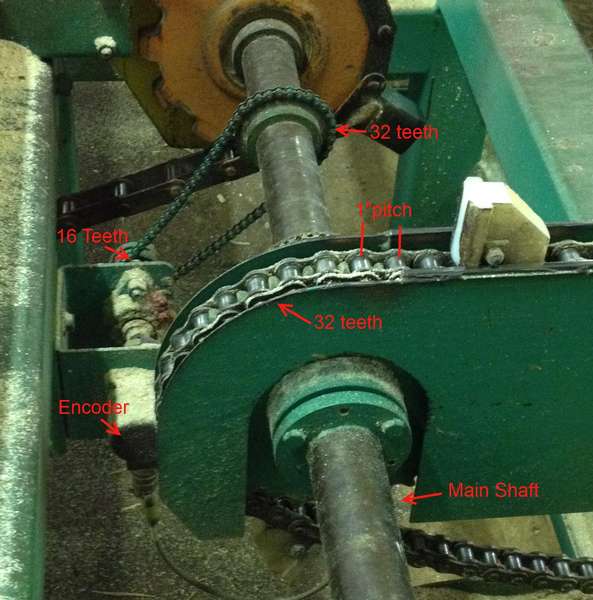Optimizer Encoder
Posted on February 16, 2016
The encoder is a key element for sawmill optimization.
The encoder converts input shaft rotation into accurate output pulses. Once the distance of chain movement is determined for each pulse, the optimization software will know how far a board has advanced on the chain. This allows for the software to accurately model board dimensions and defects.
Autolog uses an encoder with 2000 pulses per rotation and has set a standard that for every rotation of the encoder the optimizer chain will advance 16", resulting in an encoder resolution of 0.008" of chain advancement per pulse.
16" / 2000 pulses per rotation = 0.008" per pulse
The big question is what mechanical setup allows the encoder pulses to equal 16" of chain advancement?
This is achieved by using the proper mechanical gearing, to ensure that a rotation for the encoder equals the required chain advancement.
Below are two examples of mechanical setups that achieved 0.008" per pulse.
Example 1:
If the chain has a 16 tooth sprocket on the main shaft and uses 1" pitch (long) links, then by gearing the encoder with the main shaft at a 1:1 ratio, a chain advancement of 16" per rotation is achieved.
- Desired chain advancement per rotation of encoder = 16"
- Chain advancement per rotation of main shaft = 16 tooth sprocket x 1" link = 16"
- Encoder ratio = 16 tooth sprocket : 16 tooth sprocket = 1:1
- Encoder ratio x Chain advancement per rotation of main shaft = 1 x 16" = 16"
- Chain travel per rotation of encoder / Encoder pulses per rotation = 16"/ 2000 = 0.008" per pulse
Example 2:
It’s more common to see a chain with a 32 tooth sprocket on the main shaft using 1pitch links (Figure 1).
This means that the encoder cannot be linked to the main shaft at a 1:1 ratio to create the 16" of chain advancement per rotation (It would create 32" of chain advancement instead). In order to achieve the required 16" of chain advancement per rotation of the encoder, a ratio of 2:1 would have to be used (2 turns of the encoder for 1 turn of the main shaft).
- Desired chain advancement per rotation of encoder = 16"
- Chain advancement per rotation of main shaft = 32 tooth sprocket x 1” link = 32"
- Encoder ratio = 16 tooth sprocket : 32 tooth sprocket = 2:1 = 0.5
- Encoder ratio x Chain advancement per rotation of main shaft = 0.5 x 32" = 16"
- Chain travel per rotation of encoder / Encoder pulses per rotation = 16”/ 2000 = 0.008” per pulse

Figure 1: Encoder Assembly used for Example 2
In order to maintain accuracy and performance of an optimization system, the accuracy and performance of the encoder must also be maintained. If the encoder is not providing correct information to the optimization system, then the desired outcomes will not be achieved.
Stay tuned for more tips in next month’s blog post.
Billy – Process Expert


